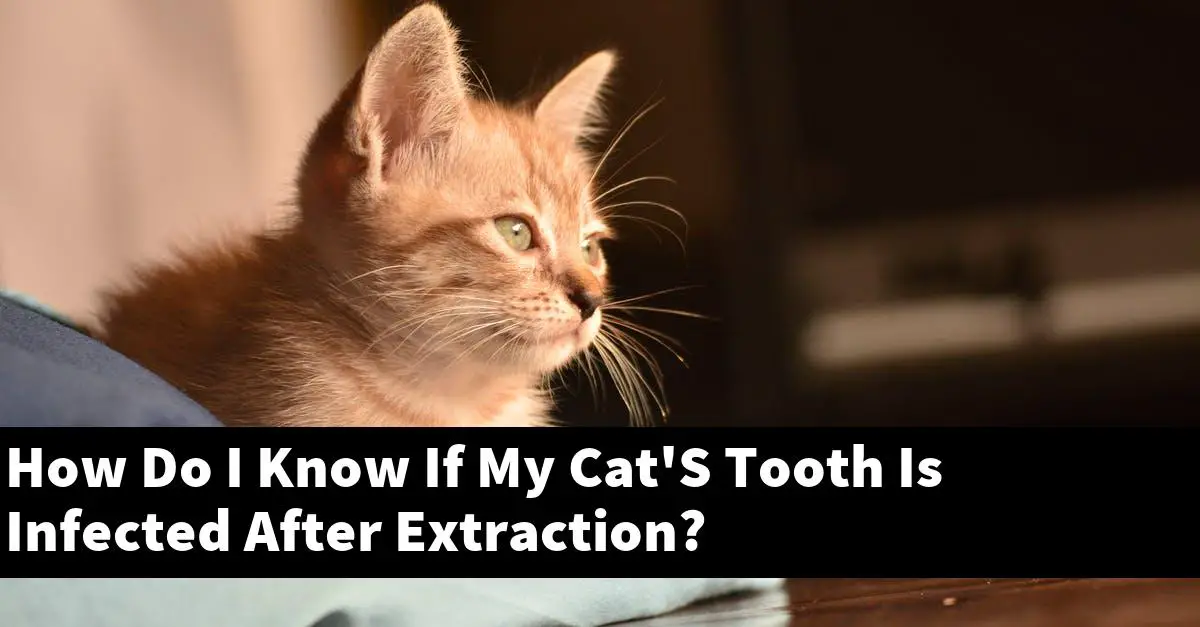After a cat’s tooth is extracted, it is important to monitor the area for infection. Signs of infection include redness, swelling, and discharge.
If you notice any of these signs, contact your veterinarian.
How do you tell if a cat has an infected tooth?
The best way to determine if a cat has an infected tooth is to take a look at the tooth and see if there is any pus or blood present. If there is, then the tooth is most likely infected and should be treated accordingly.
How long does it take for a cat’s tooth extraction to heal?
The wound that is created when a cat’s tooth is extracted will heal within a few days. The wound will start to heal by forming a scab and the area will become red and swollen.
The cat’s tooth may still hurt when it is removed but the pain should decrease over time.
Do cats need antibiotics after tooth extraction?
Extraction of a tooth requires a fair amount of force, and if a tooth is infected, antibiotics may be prescribed to prevent an infection from spreading to other areas of the body. However, antibiotics are not necessary after tooth extraction.
If an infection does develop, antibiotics may be necessary to treat it.
What to expect after cat has tooth extraction?
The cat will likely experience some discomfort following the tooth extraction. The pain may be localized to the area where the tooth was removed or it may be more diffuse.
The cat may also experience a reduced appetite and difficulty swallowing. If the tooth was impacted, the cat may experience pain when eating or drinking.
How can I tell if my cat has a sore tooth?
If your cat has a sore tooth, it will likely have a fever and may cry out in pain. The tooth may also be sore to the touch.
If the tooth is not infected, your cat may simply lick the tooth to soothe it. If the tooth is infected, your cat may lose teeth and may be in pain.
What antibiotic is used for cat tooth infection?
One antibiotic used for cat tooth infection is amoxicillin.
What does an abscess tooth look like on a cat?
An abscess tooth on a cat looks like an inflammatory mass with a reddish-purple color. The tooth may be surrounded by a yellowish-white pus-filled area.
The tooth may also have a distinct crater or depression in its surface.
Can a cat tooth abscess heal on its own?
A cat tooth abscess can usually heal on its own, but may require antibiotics to help fight any infection. If the abscess is large or deep, it may need to be surgically drained.
How can I treat my cats mouth infection at home?
There are a few different things that you can do to treat your cats mouth infection at home. You can give them antibiotics, give them pain relief, or give them both.
If your cat is already feeling a lot of pain, you can give them an NSAID (Non-Steroidal Anti-Inflammatory Drug) like ibuprofen. You can also give them a cool bath to help them feel better.
How can I treat my cats dental disease at home?
There are a few options available for treating cats’ dental disease at home. Some cats may require dental surgery, while others may only need medication or dental cleanings.
Some cats may also require dietary supplements or a special diet to help their dental health.
Dentist-recommended dental treatments for cats include:
– Dental cleanings: This is the most common type of dental treatment for cats. Dental cleanings remove plaque and tartar from the teeth.
– Dental flossing: Dental flossing removes plaque and tartar from tight spaces between teeth.
– Dental surgery: Dental surgery is sometimes necessary to remove stains or artifacts from the teeth.
Conclusion
If your cat has had a tooth extracted, it is important to monitor them for any signs of infection. Some signs of infection include: excessive drooling, pawing at the mouth, refusing to eat, and lethargy.
If you notice any of these signs, it is important to take them back to the vet for further evaluation.

